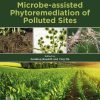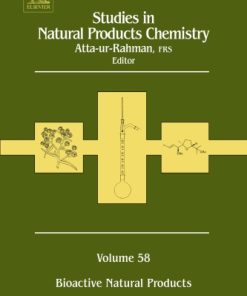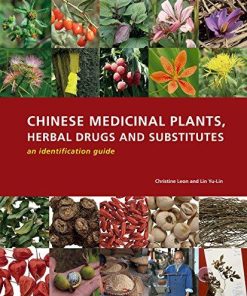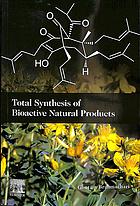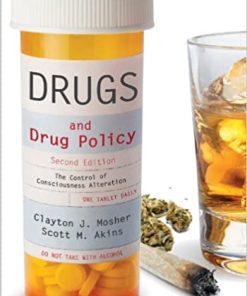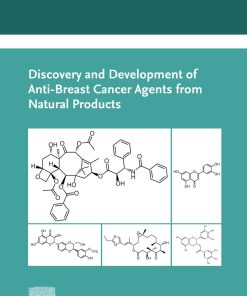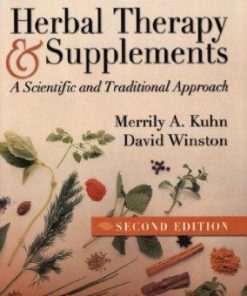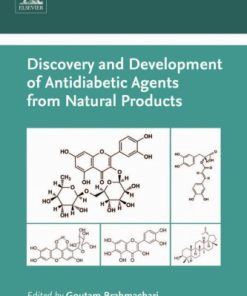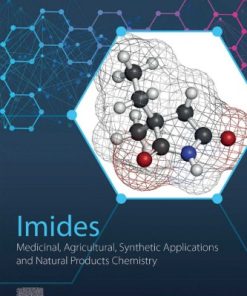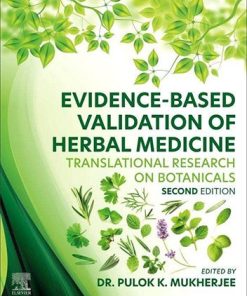(Ebook PDF) Quality Control and Evaluation of Herbal Drugs Evaluating Natural Products and Traditional Medicine 1st edition by Pulok Mukherjee 0128133988 9780128133989 full chapters
$50.00 Original price was: $50.00.$25.00Current price is: $25.00.
Quality Control and Evaluation of Herbal Drugs: Evaluating Natural Products and Traditional Medicine 1st edition by Pulok K. Mukherjee Dr. – Ebook PDF Instant Download/DeliveryISBN: 0128133988, 9780128133989
Full download Quality Control and Evaluation of Herbal Drugs: Evaluating Natural Products and Traditional Medicine 1st edition after payment.
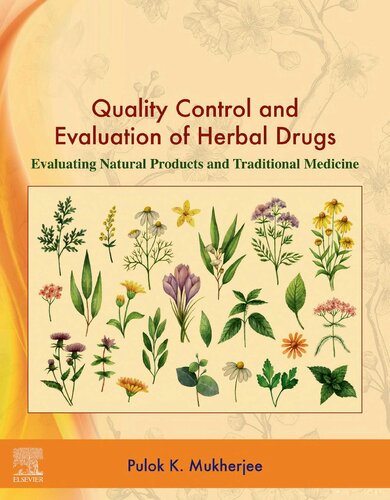
Product details:
ISBN-10 : 0128133988
ISBN-13 : 9780128133989
Author : Pulok K. Mukherjee Dr.
Quality Control and Evaluation of Herbal Drugs brings together current thinking and practices for evaluation of natural products and traditional medicines. The use of herbal medicine in therapeutics is on the rise in both developed and developing countries and this book facilitates the necessary development of quality standards for these medicines.This book elucidates on various challenges and opportunities for quality evaluation of herbal drugs with several integrated approaches including metabolomics, chemoprofiling, marker analysis, stability testing, good practices for manufacturing, clinical aspects, Ethnopharmacology and Ethnomedicine inspired drug development.
Quality Control and Evaluation of Herbal Drugs: Evaluating Natural Products and Traditional Medicine 1st Table of contents:
Chapter 1: Traditional Systems of Medicine and Harmonization
1.1 Traditional Medicine in Healthcare
1.2 AYUSH Systems of Medicine
1.2.1 Traditional Knowledge Digital Library
1.3 Ayurveda
1.3.1 Origin of Ayurveda
1.3.2 Ayurvedic Drugs and Pharmaceuticals
1.3.3 Medicinal Plants in Ayurveda
1.3.4 Globalization of Ayurvedic Medication
1.3.5 Ayurvedic Treatment and Practice
1.4 Unani
1.4.1 Therapy and Formulation of Unani Medicine
1.5 Siddha
1.6 Homeopathy
1.7 Sowa-Rigpa
1.8 Traditional Chinese Medicine
1.8.1 Concepts of Traditional Chinese Medicine
1.8.2 Quality Evaluation of Chinese Herbal Medicine
1.9 Japanese Traditional Medicine
1.10 Thai Herbal Medicine
1.11 Traditional Medicine in Bangladesh
1.12 Iranian Traditional Medicine
1.13 Malaysian Traditional Medicine
1.14 Traditional Medicine in Australia
1.15 Nature’s Natural Product Library for New Drug Discovery
1.16 Drugs Derived From TM
1.17 Harmonization of Traditional Systems and Health Practices
References
Further Reading
Chapter 2: Ethnopharmacology and Ethnomedicine-Inspired Drug Development
2.1 Ethnopharmacology and Integrative Medicine
2.2 Ethnobotany in Drug Development
2.2.1 Ethnobotany in Traditional Medicine and Modern Therapy
2.2.2 Drug Discovery From Ethnobotany
2.2.3 Ethnobotany and Drug Development
2.3 Anthropological Aspects of Ethnopharmacology
2.4 Ethnomedicine in Healthcare
2.5 Ethnomedicine in Complementary Therapeutics
2.6 Validation of Ethnomedicines
2.7 Ethnopharmacology and Translational Research
2.8 Biological Wealth of Ancient Wisdom
2.9 Approaches to Drug Development Inspired by Traditional Medicine
2.10 Intellectual Property (IP) Rights in Ethnopharmacology
2.11 Conservation of Biodiversity in Ethnopharmacology
2.11.1 Ethnobioresources and Conservation Approaches
2.12 Network Pharmacology in Ethnopharmacological Research
2.13 Reverse Pharmacology
2.14 Phytoequivalence
2.15 Phytopharmaceuticals
References
Further Reading
Chapter 3: Quality Evaluation of Herbal Medicines: Challenges and Opportunities
3.1 Factors Affecting the Quality of Herbs
3.1.1 Authentication and Reproducibility of Herbal Ingredients
3.1.2 Inter/Intra Species Variation in Plants
3.1.3 Environmental Factors
3.1.3.1 Solar Radiation
3.1.3.2 Soil Nutrients
3.1.3.3 Stress
3.1.3.3.1 Water Stress
3.1.3.3.2 Drought Stress
3.1.3.3.3 Salinity Stress
3.1.3.3.4 Chemical Stress
3.1.3.3.5 Temperature
3.1.3.3.6 Ecological Factors
3.1.3.4 Seasonal Variation
3.1.4 Geographical Location
3.1.5 Plant Parts Used
3.1.6 Time of Harvesting
3.1.7 Post harvesting Factors
3.1.8 Contaminants in Herbal Ingredients
3.1.8.1 Environmental Contaminants
3.1.8.2 Pesticides, Fumigants, and Other Toxic Metals
3.1.9 Chemical Variation in Medicinal Plants
3.2 Adulterations of Herbal Drugs
3.2.1 Various Means of Adulterations in Herbal Medicine
3.2.1.1 Substitution With Inferior Commercial Varieties
3.2.1.2 Adulteration by Artificially Manufactured Substitutes
3.2.1.3 Substitution by Exhausted Drugs
3.2.1.4 Substitution by Superficially Similar but Cheaper Natural Substances
3.2.1.5 Adulteration by Addition of Worthless Heavy Materials
3.2.1.6 Addition of Synthetic Principles
3.2.1.7 Adulteration With Inferior Drugs
3.2.1.8 Harmful Adulterants
3.2.2 Reasons of Adulteration
3.2.2.1 Confusion in Vernacular Names
3.2.2.2 Lack of Knowledge About Authentic Sources
3.2.2.3 Similarity in Morphology
3.2.2.4 Similarity in Color
3.2.2.5 Careless Collections
3.2.2.6 Other Unknown Reasons
3.3 Deterioration of Herbal Drugs
3.3.1 Light
3.3.2 Moisture
3.3.3 Temperature
3.3.4 Airic Oxidation
3.3.5 Bacteria and Molds
3.3.6 Mites and Nematode Worms
3.3.7 Insects and Moths
3.3.8 Coleoptera or Beetles
3.3.9 Control Measures for Deterioration
3.4 Substitution of Herbs
3.4.1 Substitution of the Species Belonging to the Same Family
3.4.2 Substitution of Different Species
3.4.3 Substitution of Different Parts of the Same Plant
3.4.4 Substitution Due to Same Action
3.5 Counterfeiting of Herbal Medicine
3.5.1 Types of Counterfeit Drugs and Their Consequences
3.5.2 Preventive Measures
3.5.3 Methods of Detection
3.6 Collection of Herbs
3.6.1 Methods of Bark Collection
3.6.1.1 Felling Method
3.6.1.2 Uprooting Method
3.6.1.3 Coppicing Method
3.6.2 Illustrative Examples With Discussion
3.6.3 Good Agricultural Practices
3.7 Identification and Authentication of Herbs
3.8 Taxonomy of Herbs
3.8.1 Nomenclature of Medicinal Plants
3.8.2 Author Names and Synonyms
3.8.3 Classification Systems
3.9 Herbarium Documentation for Medicinal Herbs
3.9.1 Voucher Specimen
3.9.2 Preparation of Herbarium
3.9.2.1 Collection of Plant Material
3.9.2.2 Pressing and Drying
3.9.2.3 Labeling of Specimen
3.9.2.4 Storage of Specimens
References
Further Reading
Chapter 4: Qualitative Analysis for Evaluation of Herbal Drugs
4.1 Importance of Qualitative Analysis
4.2 Moisture Content
4.2.1 Importance and Significance of Moisture Content
4.2.2 Determination of the Moisture Content of a Crude Drug
4.2.2.1 The Azeotropic Or Toluene Distillation Method
4.2.2.2 Determination of the Loss on Drying
4.2.2.3 Titrimetric Determination of Moisture Content
4.3 Ash Values
4.3.1 Principles of Determination of Ash Value
4.3.2 Methodology of Determination of Ash Value
4.3.2.1 Dry Ashing Technique for Total Ash Determination
4.3.2.2 Wet Ashing Technique for Total Ash Determination
4.3.2.3 Acid-Insoluble Ash
4.3.2.4 Water-Soluble Ash
4.3.2.5 Determination of Sulfated Ash
4.3.2.6 The Microwave Ashing Technique
4.3.2.7 Dry Ashing Using a Microwave System
4.3.3 Comparative Evaluation of Different Ashing Techniques
4.3.4 Near-Infrared Spectroscopy for the Determination of the Ash Value
4.4 Determination of Extractive Value
4.4.1 Principles and Methodology of the Determination of Extractive Values for Medicinal Plants
4.4.2 Procedures for Determination of Extractive Values
4.4.2.1 Determination of Water-Soluble Extractive
4.4.2.2 Determination of the Ethanol-Soluble Extractive
4.4.2.3 Determination of Hexane-Soluble Extractive
4.4.2.4 Volatile Ether-Soluble Extractive
4.4.2.5 Nonvolatile Ether-Soluble Extractive
4.5 Residual Solvents
4.5.1 Classification of Residual Solvents
4.5.1.1 Class 1 Solvents: Solvents to Be Avoided
4.5.1.2 Class 2 Solvents: Solvents to Be Limited
4.5.1.3 Class 3 Solvents: Solvents With Low Toxic Potential
4.6 Total Solids
4.6.1 Significance and Use
4.7 Determination of Crude Fiber
4.8 Bitterness Determination
4.8.1 Procedure for Determination of Bitterness
4.9 Swelling Index
4.9.1 Determination of Swelling Index
4.10 Foaming Index
4.10.1 Determination of the Foaming Index
4.10.1.1 Method 1
4.10.1.2 Method 2
4.10.1.3 Foam Test
4.11 Hemolytic Activity
4.11.1 Determination of Hemolytic Activity
4.11.1.1 Method 1
4.11.1.2 Method 2
4.12 Total Tannin Content
4.12.1 Hydrolysable Tannins
4.12.1.1 Gallotannins
4.12.1.2 Ellagiotannins
4.12.2 Complex Tannins
4.12.2.1 Condensed Tannins
4.12.3 Pseudotannins
4.12.4 Determination of the Tannin Content (WHO, 1998)
4.12.4.1 Titrimetric Method
4.12.4.2 Spectrophotometric Method
4.12.4.3 Alkaline Ethanol Precipitation Method
4.12.5 The Tannin Content of Several Medicinal Plants
4.13 Total Phenolic Contents
4.14 Total Flavonoid Contents
4.14.1 Method 1
4.14.2 Method 2
4.14.3 Method 3
4.15 Heavy Metals
4.15.1 Toxic Elements
4.15.2 Effects of Heavy Metals on Secondary Metabolites
4.15.3 Atomic Absorption Spectrometry (AAS)
4.15.3.1 Sample Preparation
4.15.4 Instrumentation
4.15.5 Techniques Based on Atomic Absorption Spectrometry
4.15.5.1 Calibration Curve Method
4.15.5.2 Standard Addition Method
4.15.5.3 Internal Standard Method
4.15.6 Limit Test for Arsenic
4.15.6.1 Preparation of the Sample by Acid Digestion
4.15.6.2 Apparatus and Methodology
4.15.6.3 Preparation of Standard Stain
4.15.6.4 Limit Test for Cadmium and Lead
4.15.6.4.1 Apparatus
4.15.6.5 Preparation of the Sample
4.15.6.5.1 Method
4.15.7 Limit Test for Mercury
4.15.7.1 Materials and Methods
4.15.7.2 Apparatus
4.15.7.3 Standard Preparation
4.15.7.4 Analysis Method
4.16 Pesticides
4.16.1 Pest Control and Pesticide
4.16.2 Chemical Pest Control
4.16.3 Different Pesticides and Chemical Composition
4.16.4 Various Forms of Preparations of Pesticides Used
4.16.4.1 Classification of Pesticides
4.16.4.1.1 Fungicides
4.16.4.1.2 Herbicides
4.16.4.1.3 Insecticides
4.16.4.1.4 Acaricides
4.16.4.1.5 Nematocides
4.16.4.1.6 Rodenticides
4.16.4.1.7 Bactericides
4.16.5 Adverse Effects of Different Pesticides
4.16.6 Maximum Limit of Pesticide Residues for Herbal Drugs
4.16.7 Limits for Pesticides
4.16.8 Pests and Pest Control
4.16.8.1 Microbes
4.16.8.2 Insects
4.16.8.3 Noninsect Pests
4.16.8.4 Weeds
4.16.9 Different Classes of Pesticide Based on Chemical Composition
4.16.10 Method for Determination of Pesticides
4.16.10.1 Method 1
4.16.10.2 Method 2
4.16.10.3 Method 3
4.16.10.4 Method 4
4.16.10.5 Method 5
4.17 Aflatoxins and Other Microbial Contents
4.17.1 Factors Affecting Microbial Content
4.17.2 Microbial Quality Standards of WHO
4.17.3 Principles for the Determination of Microbial Load
4.17.4 Procedures for the Determination of Microbial Load
4.17.4.1 Total Aerobic Viable Count
4.17.4.2 Growth Promotion by Media
4.17.4.3 Appropriateness of the Enumeration Method in the Presence of Product
4.17.4.4 Membrane Filtration Method
4.17.4.5 Pour Plate Method
4.17.4.6 Most Probable Number (MPN) Method
4.17.5 Examples of the Importance of Microbial Load According to the Indian Pharmacopeia
4.17.6 Detection of the Presence of Specific Microorganisms
4.17.6.1 Escherichia coli
4.17.6.2 Salmonella Species
4.17.6.3 Pseudomonas Species
4.17.6.4 Candida albicans
4.17.7 Determination of Aflatoxins
4.18 Essential Oil in Crude Drugs
4.18.1 Principles and Methods for Determination of Essential Oil Content
4.18.1.1 Distillation
4.18.1.2 Hydrodiffusion
4.18.1.3 Water Distillation
4.18.1.4 Water and Steam Distillation
4.18.1.5 Direct Steam Distillation
4.18.1.6 Cohobation
4.18.1.7 Hydrodistillation Through Clevenger Apparatus
4.18.1.8 Microdistillation Method
4.18.2 Simultaneous Extraction Coupled to TLC
4.18.3 Direct Sampling From the Secretory Structures
4.18.4 Supercritical Fluid Extraction
4.18.5 Microwave-Assisted Extraction
4.18.6 Illustrative Example of the Determination of the Essential Oils in Crude Drugs
4.18.7 Preliminary Quality Control Parameters for Essential Oils
4.18.7.1 Total Eugenol Content
4.18.7.2 Determination of Total Cineole Content
4.18.7.3 Determination of Total Aldehyde Content in Volatile Oil
4.18.7.4 Determination of the Carvone Content of Volatile Oil
References
Further Reading
Chapter 5: Morphological and Microscopical Evaluations
5.1 Organoleptic Evaluation
5.1.1 Attributes of Organoleptic Evaluation
5.1.1.1 Color
5.1.1.2 Size
5.1.1.3 Odor and Taste
5.1.1.4 Surface Characteristic: Texture and Fracture
5.2 Macromorphological Evaluation
5.3 Macromorphology of Crude Drugs From Barks
5.3.1 Nature of Curvature
5.3.2 Surface Characteristics
5.3.3 Characteristics of Fracture
5.3.4 Characteristics of Transverse Surface
5.3.5 Histology of Barks
5.4 Macromorphology of Crude Drugs From Roots
5.4.1 Modification for Storage of Food
5.4.2 Modifications for Support
5.4.3 Modifications for Special Functions
5.5 Macromorphology of Crude Drugs From Stems
5.5.1 Underground Stem
5.5.2 Stem Tendrils
5.5.3 Thorn
5.5.4 Aerial Stem
5.5.5 Weak Stems
5.5.6 Subaerial Weak Stem
5.5.7 Herbaceous and Woody Stems
5.6 Macromorphology of Crude Drugs From Rhizomes
5.6.1 Occurrence or Form of the Rhizome
5.6.2 Shape of the Drug
5.6.3 Surface Characters
5.6.4 Transverse Section
5.7 Macromorphology of Crude Drugs From Woods
5.7.1 Size and Color
5.7.2 Fracture and Hardness When Split
5.7.3 Transverse Surface
5.8 Macromorphological Description of the Entire Aerial Parts
5.9 Macromorphology of Crude Drugs From Leaves
5.9.1 Types of Leaves
5.9.2 Structural Distribution of Leaves
5.9.3 Arrangement and Position of Leaves
5.9.4 Surface Appearance and Texture
5.10 Macromorphological Description of Herbal Drugs Containing Flowers
5.10.1 Receptacle of Floral Drugs
5.10.2 Characteristics of Inflorescence
5.10.3 Arrangement of Floral Parts on Thalamus
5.11 Macromorphological Description of Fruit Drugs
5.11.1 Shape and Size
5.11.2 Types of Fruits
5.12 Macromorphological Evaluation of Crude Drugs Obtained From Seeds
5.12.1 Shape of the Seeds
5.12.2 Seed Coat
5.12.3 Special Features of Seeds
5.13 Macromorphological Evaluation of Cellular Materials or Unorganized Drugs
5.13.1 Evaluation of Physical State
5.13.2 Vegetable Debris
5.13.3 Effect on Heating
5.13.4 Morphological Characteristics of a Few Unorganized Herbal Drugs
5.14 Cytomorphological Evaluation of Herbal Drugs
5.14.1 Analytical Application of Cytomorphology
5.14.1.1 Epidermis
5.14.1.2 Stomata
5.14.1.3 Trichomes
5.14.2 Basic Cell Types and Cell Inclusions Present in Herbal Drugs
5.14.2.1 Parenchyma
5.14.2.2 Sclerenchyma
5.14.2.3 Collenchyma
5.14.2.4 Xylem
5.14.2.5 Phloem
5.14.2.6 Epidermis
5.14.2.7 Periderm
5.14.2.8 Secondary Tissues
5.14.2.9 Calcium Oxalate
5.14.2.10 Calcium Carbonate
5.14.2.11 Starch
5.15 Microscopical Techniques
5.15.1 Instruments for Microscopical Study
5.15.1.1 Camera Lucida
5.15.1.2 Photomicrography
5.15.1.3 Modified Light Microscopy
5.15.1.4 Polarizing Microscopy
5.15.1.5 Phase Contrast Microscopy
5.15.1.6 Electron Microscopy
5.15.1.7 Ultraviolet Microscopy
5.15.2 Microchemical Testing of Herbal Drugs
5.15.3 Microchemical Precipitation
5.15.4 Micro-sublimation
5.16 Evaluation of Crude Drugs by Microscopy
5.16.1 Preparation of Crude Drug Sample for Microscopical Examination
5.16.2 Clearing Reagents and Preliminary Treatment
5.16.2.1 Chloral Hydrate Solution
5.16.2.2 Phenols
5.16.2.3 Nitric Acid
5.16.2.4 Hydrochloric Acid
5.16.2.5 Hydrofluoric Acid
5.16.2.6 Ether–Ethanol Reagent
5.16.2.7 Sodium Hypochlorite Solution
5.16.2.8 Caustic Alkali
5.16.2.9 Clove Oil
5.17 Quantitative Analytical Microscopy
5.17.1 Optical Micromeritics
5.17.2 Micrometers
5.17.3 Micrometry
5.17.4 Leaf Characters for the Evaluation of Impurity
5.17.4.1 Vein Islet and Veinlet Termination
5.17.4.2 Stomatal Index
5.17.4.3 Palisade Ratio
5.17.4.4 Lycopodium Spore Method
References
Chapter 6: Extraction and Other Downstream Procedures for Evaluation of Herbal Drugs
6.1 Basic Principles and Rationale
6.2 Factors Affecting Extraction of Herbal Drugs
6.2.1 Choice of Solvents
6.2.2 Types of Extracts
6.2.3 Raw Materials
6.2.4 Choice of Solvent
6.2.5 Conditions for Extraction
6.2.6 Selection, Collection, and Identification of Plant Material
6.2.7 Drying of the Crude Drugs
6.2.8 Comminution and Classification
6.2.8.1 Medicinal Leaves and Herbs
6.2.8.2 Roots and Barks
6.2.8.3 Seeds and Fruits
6.3 Methods of Extraction
6.3.1 Factors Affecting the Choice of Extraction Process
6.3.2 Maceration, Digestion, and Remaceration
6.3.2.1 Advantages and Disadvantages
6.3.2.2 Percolation and Repercolation
6.3.2.3 Examples of Experiments on Percolation and Observations
6.3.2.4 The Factors Affecting the Percolation Process
6.3.3 Infusion and Decoction
6.3.4 Vortical or Turbo Extraction
6.3.5 Ultrasound Extraction
6.3.6 Extraction by Electrical Energy
6.3.7 Countercurrent Extraction
6.3.7.1 Continuous Countercurrent Extraction
6.3.7.2 Relative Countercurrent Extraction
6.3.8 Hot Continuous Extraction—Soxhlation
6.3.8.1 Advantages of a Conventional Soxhlet Apparatus
6.3.8.2 Disadvantages of a Conventional Soxhlet Apparatus
6.3.8.3 High-Pressure Soxhlet Extraction
6.3.8.4 Automated Soxhlet Extraction
6.3.8.5 Ultrasound-Assisted Soxhlet Extraction
6.3.8.6 Microwave-Assisted Soxhlet Extraction
6.3.9 Extraction of Essential Oil
6.3.9.1 Distillation
6.3.9.2 Hydro Diffusion
6.3.9.3 Water Distillation
6.3.9.4 Water and Steam Distillation
6.3.9.5 Direct Steam Distillation
6.3.9.6 Cohobation
6.3.10 Microwave Extraction
6.3.10.1 Principles
6.3.10.2 Microwave-Assisted Subcritical and SFE
6.3.10.3 Microwave-Assisted Enzymatic Extraction
6.3.11 Supercritical Fluid Extraction
6.3.12 Pressurized Liquid Extraction
6.3.12.1 Illustrative Example
6.3.12.2 Pressurized Hot Water Extraction (PHWE)
6.3.13 General Protocols for Extraction of Phytoconstituents
6.4 Effect of Solvent, Solvent Mixtures, and Solution on Extraction
6.4.1 Solvents Used for Extractions
6.4.2 Extraction Enhancement by Emerging Extraction Solvents
6.4.2.1 Ionic Liquids
6.4.2.2 Other Enhancements
6.4.3 Properties of Solutions
6.4.4 Types of Solutions
6.4.4.1 Azeotropic Mixtures
6.4.4.2 Solubility of Active Constituents
6.4.4.3 The Phase Rule
6.4.4.4 Solubility Expressions
6.4.4.5 Solvent–Solute Interactions
6.4.5 Classification of the Solvents
6.4.5.1 Polar Solvents
6.4.5.2 Semipolar Solvents
6.4.5.3 Nonpolar Solvents
6.4.6 Influence of Solvents
6.4.7 Combined Effect of pH and Solvents
6.4.8 Examples of Effects of Solvents on the Extraction
6.5 Characteristics of Phytoconstituents
6.5.1 Polarity
6.5.2 pH
6.5.3 Thermostability
6.6 Interfering Compounds in Extraction of Desired Phytoconstituents
6.6.1 Lipids
6.6.2 Colors and Pigments
6.6.3 Plasticizers
6.6.4 Water Soluble Polysaccharides and Other Carbohydrate Polymers
6.7 Extraction Methods for Specific Phytochemical Groups
6.7.1 Alkaloids
6.7.2 Carotenoids
6.7.3 Fixed Oils, Fats, and Waxes
6.7.4 Glycosides
6.7.5 Phenolic Compounds
6.7.6 Proteins
6.7.7 Polysaccharides
6.8 Treatment of Drug Residue After Extraction–Downstream Processing
6.8.1 Sanitization of Extracts and Elimination of Solvents
6.8.2 Removal of Solvents
6.8.2.1 Rotary Vacuum Evaporator
6.8.2.2 Tube Vaporizers
6.8.2.3 Falling Film Vaporizer
6.8.3 Freeze Drying
6.8.4 Reverse Osmosis
6.8.5 Particle Size Reduction
References
Further Reading
Chapter 7: Bioactive Phytocomponents and Their Analysis
7.1 Bioactive Phytocomponents and Their Classification
7.1.1 Classification of Bioactive Phytocomponents
7.2 Importance of Phytoconstituents in Therapy
7.3 Qualitative Analysis of Crude Drug Extracts and Isolates
7.3.1 Tests for Alkaloids
7.3.2 Tests for Tannins
7.3.3 Test for Glycosides
7.3.3.1 Tests for Anthraquinone Glycosides
7.3.3.2 Tests for Steroid Glycosides
7.3.3.3 Tests for Cardiac Glycosides
7.3.3.4 Tests for Coumarin Glycosides
7.3.3.5 Tests for Cynophoric Glycoside
7.3.3.6 Tests for Flavonoid Glycoside
7.3.4 Test for Flavonoids
7.3.5 Tests for Phytosterols
7.3.6 Tests for Triterpenes
7.3.7 Test for Saponins
7.3.8 Other Polyphenols
7.3.9 Tests for Resins
7.3.10 Tests for Fixed Oils and Fats
7.3.11 Tests for Carbohydrates
7.3.11.1 Reagents
7.3.11.2 Identification of Carbohydrates
7.3.11.3 Some Distinctive Qualitative Chemical Analyses of Monosaccharides
7.3.11.4 Some Distinctive Qualitative Chemical Analyses of Disaccharides
7.3.11.5 Some Distinctive Qualitative Chemical Analyses of Polysaccharides
7.3.12 Test for the Presence of Carotenoids
7.4 Alkaloids and Their Analysis
7.4.1 Importance of Alkaloids in Phytotherapy
7.4.2 Classification of Alkaloids
7.4.2.1 Chemical Classification
7.4.2.2 Distribution of Alkaloids in Plant Kingdom
7.4.2.3 Biosynthetic Classification of Alkaloids
7.4.3 Pyridine–Piperidine Alkaloids
7.4.3.1 Areca
7.4.3.2 Lobelia
7.4.3.3 Nicotine
7.4.4 Tropane Alkaloids
7.4.4.1 Belladonna
7.4.4.2 Solanaceous Alkaloids
7.4.4.3 Coca Alkaloids
7.4.5 Quinoline Alkaloids
7.4.5.1 Cinchona Alkaloids
7.4.6 Isoquinoline Alkaloids
7.4.6.1 Ipecac
7.4.6.2 Sanguinaria
7.4.6.3 Hydrastis
7.4.6.4 Tubocurarine Chloride
7.4.6.5 Opium
7.4.7 Indole Alkaloids
7.4.7.1 Rauwolfia serpentina
7.4.7.2 Yohimbine
7.4.7.3 Catharanthus Alkaloids
7.4.7.4 Nux vomica
7.4.7.5 Physostigmine
7.4.7.6 Ergot
7.4.8 Imidazole Alkaloids
7.4.8.1 Pilocarpine
7.4.9 Steroidal Alkaloids
7.4.9.1 Veratrum viride
7.4.10 Alkaloidal Amines
7.4.10.1 Ephedrine
7.4.10.2 Colchicine
7.4.11 Purine Bases
7.4.11.1 Caffeine-Containing Drugs
7.4.11.2 Theophylline
7.4.11.3 Theobromine
7.5 Volatile Oils, Spices, and Their Analysis
7.5.1 Chemical Nature of Volatile Oils and Their Analysis
7.5.2 Hydrocarbons Containing Oils
7.5.2.1 Unsaturated Acyclic Hydrocarbons
7.5.2.2 Aromatic Hydrocarbons
7.5.2.3 Alicyclic Hydrocarbon
7.5.3 Oils Containing Alcohol
7.5.3.1 Saturated Aliphatic Alcohols
7.5.3.2 Unsaturated Aliphatic Alcohols
7.5.4 Oils Containing Cineole
7.5.4.1 Estimation of Cineole
7.5.4.2 Oils of Therapeutic Importance
7.5.5 Oils Containing Aldehydes
7.5.6 Volatile Oils Containing Ketone
7.5.7 Oils Containing Phenol
7.5.7.1 Oils of Therapeutic Importance
7.5.8 Oils Containing Esters
7.5.9 Estimation of Oil of Mustard
7.5.10 Physical Characteristics of Volatile Oils
7.5.11 Qualitative and Quantitative Analysis of Volatile Oils
7.6 Fixed Oils, Fats, and Waxes
7.6.1 Fixed and Volatile Oils
7.6.2 Chemical Nature of Fixed Oils, Fats, and Their Analysis
7.6.2.1 Fixed Oils of Therapeutic Importance
7.6.2.2 Fats of Therapeutic Importance
7.6.3 Main Characteristic Features of Fixed Oils
7.7 Phenylpropanoids and Their Analysis
7.7.1 Classification of Phenylpropanoids
7.7.2 Individual Classes of Phenylpropanoids With Examples
7.8 Flavonoids
7.8.1 Classification
7.8.1.1 Flavanols
7.8.1.2 Flavanones
7.8.1.3 Isoflavones
7.8.1.4 Flavones
7.8.2 Examples of Classes of Flavonoids
7.8.2.1 Rutin
7.8.2.2 Apigenin
7.8.2.3 Milk Thistle
7.8.2.4 Quercetin
7.8.2.5 Hesperetin
7.9 Resins and Resinous Plant Drugs and Their Analysis
7.9.1 Resins and Their Importance in Phytotherapy
7.9.1.1 Podophyllum
7.9.1.2 Etoposide
7.9.1.3 Teniposide
7.9.2 Chemical Classes of Resins and Their Analysis
7.9.3 Quantitative Chemical Analysis of Some Resinous Compounds
7.10 Tannins of Therapeutic Importance and Their Analysis
7.10.1 Chemical Classification of Tannins and Their Quantitative Analysis
7.11 Terpenoids and Their Analysis
7.11.1 Monoterpenoids
7.11.2 Sesquiterpenoids
7.11.3 Diterpenoids
7.11.4 Triterpenoids
7.11.5 Tetraterpenoids and Carotenoids
7.12 Glycosidal Components and Their Analysis
7.12.1 Chemical Nature of Glycosides and Their Analysis
7.12.2 Anthraquinone Glycosides
7.12.2.1 C. sagrada or Rhamnus purshiana
7.12.2.2 Frangula or Buckthorn Bark
7.12.2.3 Aloe
7.12.2.4 Rhubarb, Rheum, or Chinese Rhubarb
7.12.2.5 Senna Leaf
7.12.3 Saponin Glycosides
7.12.3.1 Dioscorea
7.12.3.2 Licorice
7.12.3.3 Ginseng
7.12.4 Cyanogenic Glycosides
7.12.5 Isothiocyanate Glycosides
7.12.5.1 Other Organosulfur Drugs
7.12.5.1.1 Garlic
7.12.6 Alcohol Glycosides
7.12.7 Aldehyde Glycosides
7.12.8 Phenol Glycosides
7.13 Fluorescent Substances and Their Analytical Parameters
7.14 Coloring Matters and Their Analysis
7.14.1 Plastid Pigments in Plants and Their Analysis
7.14.2 Pigments of the Cell Saps in Plants
7.14.2.1 Anthoxanthins
7.14.2.2 Anthocyanins
7.15 Proteinous Components and Their Analysis
7.15.1 Therapeutically Important Plant Proteins and Their Analysis
7.16 Steroids
7.16.1 Sterols
7.16.2 Steroidal Compounds of Therapeutic Importance and Their Analysis
7.16.2.1 Steroidal Saponins and Cardiac Glycosides
7.16.2.2 Other Cardioactive Drugs
7.16.3 Quantitative Test Procedure and Assay Methods for Cardioactive Drugs
7.17 Carbohydrates and Their Analysis
7.17.1 Classification
7.17.2 Inulin
7.17.3 Cellulose
7.17.4 Agar
7.17.5 Irish Moss and Iceland Moss
7.17.6 Pentosans
7.17.7 Polyuronides
7.17.8 Pectic Substances
7.17.9 Gums
7.17.10 Acacia
7.17.11 Tragacanth
7.17.12 Mucilages
People also search for Quality Control and Evaluation of Herbal Drugs: Evaluating Natural Products and Traditional Medicine 1st:
the disappearance of moral knowledge
the two directions of moral knowledge are
sarah mcgrath moral knowledge
moral knowledge definition
moral knowledge examples
Tags:
Quality Control,Evaluation,Herbal Drugs,Evaluating Natural,Products,Traditional Medicine,Pulok Mukherjee
You may also like…
Chemistry - Biochemistry
Science (General)
Medicine - Pharmacology
Uncategorized
Winston & Kuhn’s Herbal Therapy and Supplements: A Scientific Traditional – Ebook PDF Version
Medicine - Pharmacology
Chemistry - Organic Chemistry
Imides : medicinal, agricultural, synthetic applications and natural products chemistry Luzzio
Medicine - Natural Medicine


